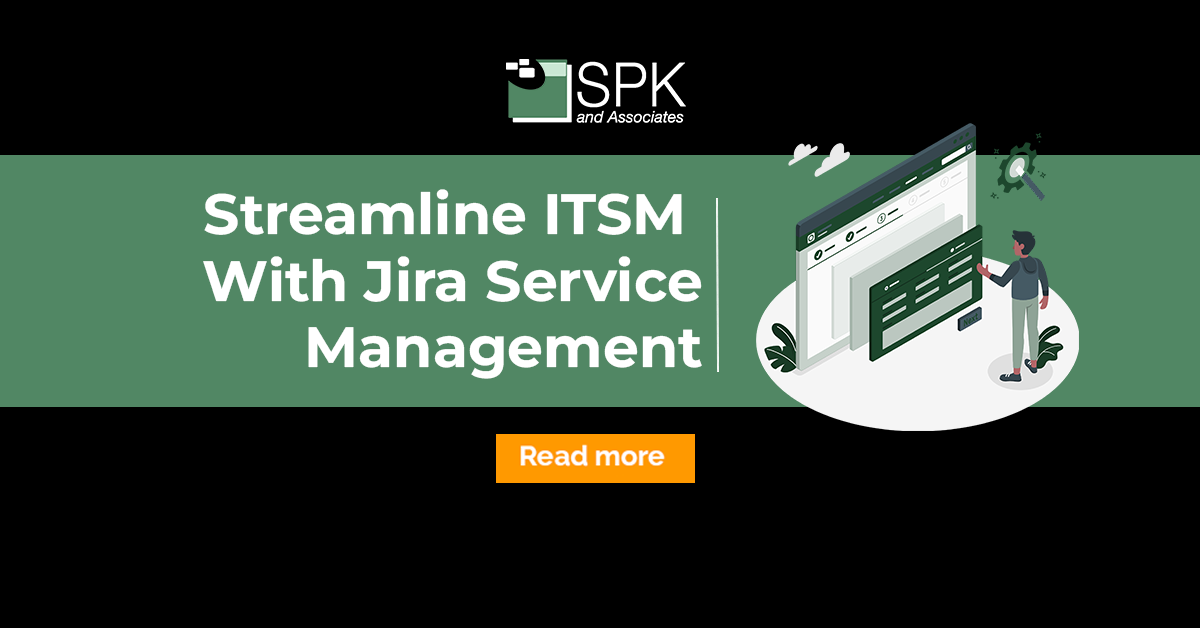Originally created in 2013 as a special Jira project template, Jira Service Desk, or now Jira Service Management (JSM), is a powerful ITSM tool that helps development, IT and business teams collaborate in a standardized way. Atlassian created JSM because nearly 40% of their Jira customers were using Jira to handle service requests, including many teams like HR or Marketing that were not IT-related. To understand how Jira Service Management drives productivity and a unified view of work, let’s dig deeper into some of the components of ITSM.
Jira Service Management ITSM Categories
Out-of-the-box, JSM comes with 4 main categories. They are described below.
Service Requests
Service requests are requests for information, access to a service, or for something new to be provided. Sometimes these requests come from the user. Other times the requests come from their representative, such as their supervisor or someone from the HR or onboarding teams. Here are some common service requests:
| Request Type | Example |
| A request for a service delivery action | Please setup a new Salesforce account |
| A request for a service delivery action | I need to reset my password. |
| A request for information | How do I access my account? |
| A request for information | Where are the instructions to add my new printer? |
| A request for provision of a resource or service | I need a new laptop |
| A request for provision of a resource or service | Please issue me a new mobile device |
| A request for access to a resource or service | Please configure my user account to print color on the main printer. |
Incidents
Incidents are unplanned events that disrupt or reduce the quality of your service (or threaten to do so). An example of an incident might be something like “Our web application is no longer functioning.” An incident can be upgraded to a major incident (or Problem) if it represents a critical disruption to a service that requires an emergency response.
Problems
Problems can be classified as the “root causes” of the incidents. While an Incident can be something that does not have a complicated root cause, Problems can be recurring or can cause multiple Incidents. Requests in the Problems category aim to identify and eliminate the root causes of an incident, such as “Internal tooling keeps crashing.”
Changes
Changes are part of Change Management and include anything that involves organizational changes to IT infrastructure. Examples include rolling out new services or upgrading software. Changes streamline service delivery by simplifying and automating change enablement (change management) processes.
Extra Tidbit!
If you’d like to see a Jira Service Management category in action before adding it to your service project, you can create a new ITSM project and use the sample space to test, explore and learn about the ITSM categories. Learn more about that here.
Streamlining Information Technology
The best thing about JSM is that it’s flexible. The bad thing about JSM is it is so flexible it can easily be misconfigured. Understanding what a good ITSM service desk looks like will help immensely.
JSM is a robust and flexible self-service portal that can be modified to fit almost any process for service. You can customize intake forms to meet needs from any team, including those from IT teams, engineering teams, HR teams, marketing teams and more. JSM integrates with other Atlassian tools. Therefore, teams such as IT operations, development, and product management love it, because it enables feature developments along with bug fixes.
For non-technical teams, JSM flexes its muscle by providing built-in queue functionality to automatically triage and prioritize items so critical items can get addressed quickly. Queues help organize requests and allow service organizations to understand workloads. Defining different workflows with request types allows you to put automation in place. In turn, this streamlines the process of alerting the proper staff members for the next steps. Next steps can include approvals and good communication with the requestor.
Integration with Confluence for Knowledge Support
Regardless of the type of service desk you’re running, you’ll want to ensure that you are sharing self-service information with users. Obviously, this helps limit the amount of requests that come in. In addition, it provides service quickly to users. Atlassian’s team workspace tool, Confluence, is a great knowledge base. Many organizations that use Jira or JSM are likely already using it. What you might not know is that when Confluence is integrated with JSM, it streamlines delivery of critical information and acts as an extension of JSM’s service delivery capabilities.
Confluence is great for documentation of new features and systems for development and product teams. But Confluence can also be used effectively for user documentation, FAQs, and how-to information that supports a service desk environment. You can integrate JSM and Confluence in order to streamline knowledge base support.
One way to use JSM’s self-service portal for IT and non-IT teams is to require information prior to submitting a ticket. This allows users to potentially solve problems on their own and thus decreases the need for the service desk. This type of self-service creates a better experience for the users and less work for the service desk.
There is another way that JSM and Confluence combine for a powerful ITSM system. First, JSM+Confluence gives the agents (those that are doing the work for the service request) the ability to look up information in the knowledge base to share with customers. Then, the agents can reference this knowledge as they solve problems and potentially add more information to the knowledge base.
It is clear that agents that use internal knowledge information can address user service requests more quickly and easily. Agents that document how to resolve specific user requests are improving and expanding the knowledge base. All users in your organization will benefit from the added expertise, even when the agents are not available. Plus, Confluence is easily editable, so it can be kept current. Living documents are great!
IT Asset Management
In mid-2020, Atlassian acquired makers of Insight, Mindville. This acquisition was perfect for those in the Atlassian ITSM space. If you are unfamiliar with Insight, it provides full visibility into assets and services, which is a key component to delivering great customer and employee service experiences within ITSM. Insight offers visibility into dependencies so you can manage assets and configuration items (CIs), quickly troubleshoot incidents, and minimize the risk of changes.
Using Insight, organizations gain visibility into infrastructure dependencies to better manage assets, understand asset inventory, and minimize the downstream impact of changes. Insights allows users to view different asset dependencies and easily assess the impact of those relationships using a graphical view. There is even a dynamic component that automatically follows assets as they move around the network or are changed by users.
Insights puts crucial asset information at the fingertips of the IT organization. Atlassian’s Insight feature helps IT teams reduce MTTR by showing what services are affected, and how each of those relates to one another. Using visualization, Insights allows teams to understand the “who, what, when, and where” of any issue. It’s very flexible and easy to implement. Your CMDB information can be imported from cloud providers or by using CSV, JSON, or REST-API.
What Do We Think About Jira Service Management?
Jira Service Management is a key application for those in the business of information management, It’s not just for IT. JSM is a consumer-grade experience with a central customer portal. It scales to unify and satisfy IT, Finance, HR, Legal, Marketing and other business teams. JSM provides the ability to solve issues quicker and faster with automation, which allows your organization to scale.
IT can have customizable SLAs and advanced SLA metrics for accountability. Since JSM has seamless integration with other Atlassian tools, it easily integrates with Jira Software, Confluence, Bitbucket and more. It is easy to streamline ITSM and other processes with JSM.
Reach out to us if you need help getting started!





